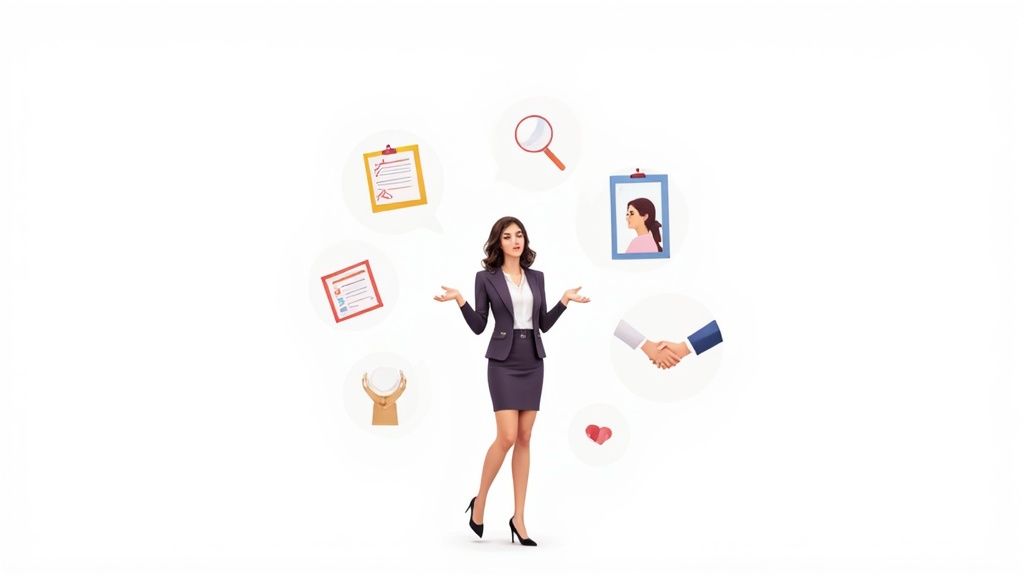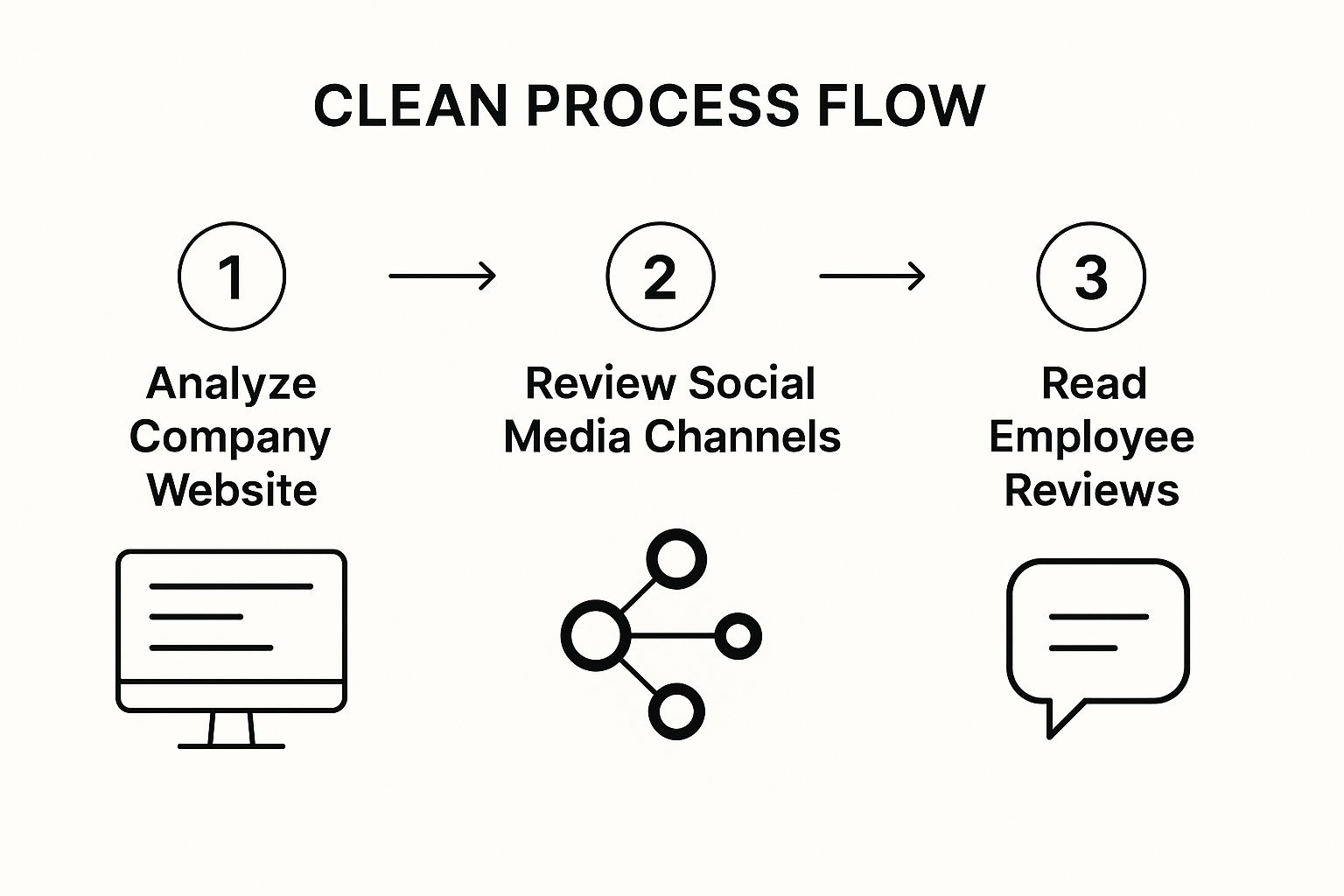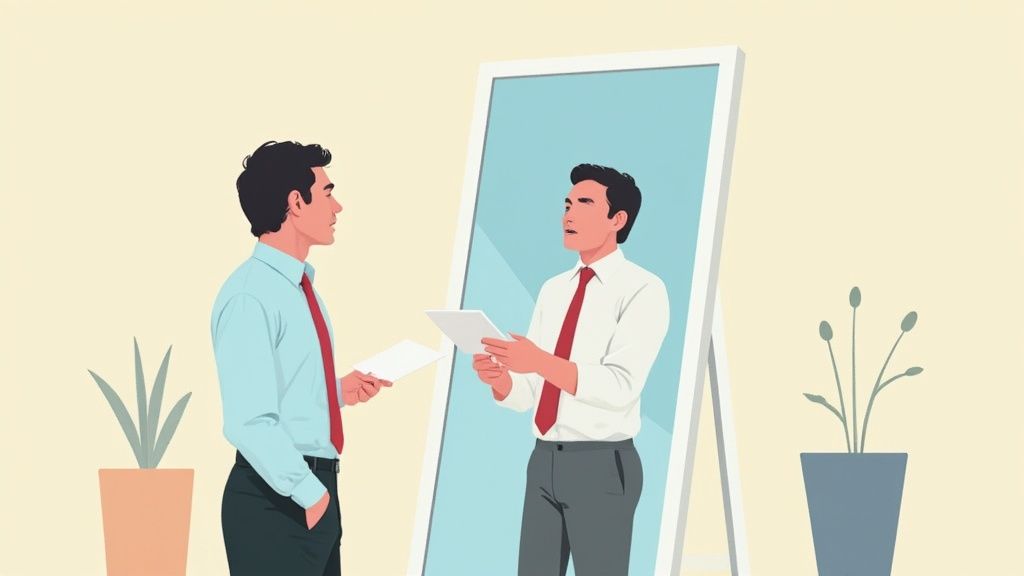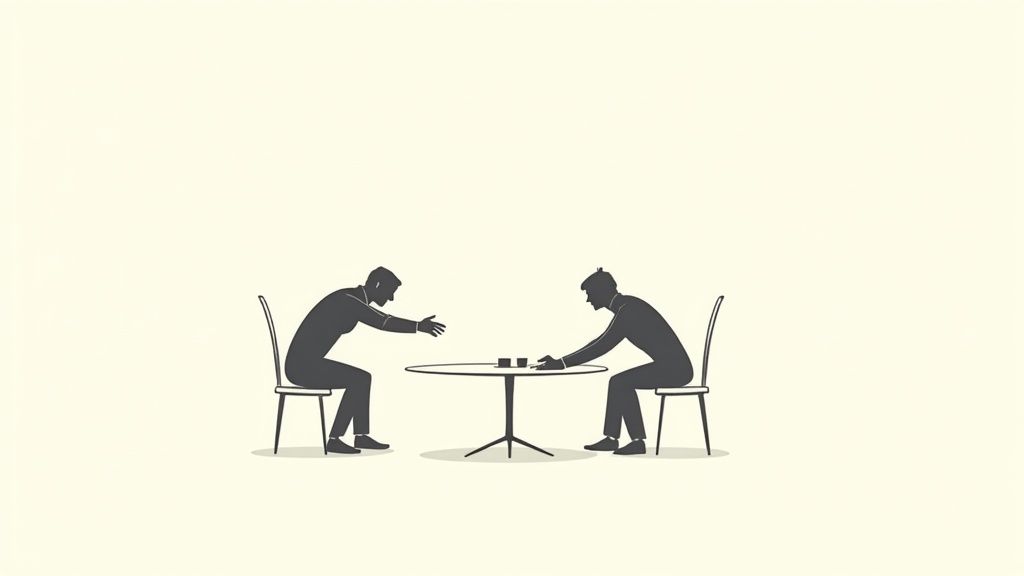
8 Essential First Job Interview Tips to Succeed in 2025
Your first job interview can feel like the final boss in a video game you’ve just started playing. The stakes are high, the rules are new, and everyone seems to have conflicting advice. But what if you could walk into that room not with anxiety, but with a clear, strategic playbook? This guide moves beyond the generic ‘be confident’ advice to give you a concrete, step-by-step framework.
We will break down the essential first job interview tips into actionable strategies, from decoding company culture before you even speak to a recruiter, to crafting a thank-you note that seals the deal. Each tip is designed to build on the last, transforming your preparation from a scattered checklist into a powerful, cohesive strategy. Whether you’re a recent graduate or transitioning into a new field, these insights will equip you to handle tough questions, showcase your unique value, and turn your first interview from a source of stress into a genuine opportunity to shine.
1. Research the Company Thoroughly
Walking into your first job interview without knowing the company is like trying to navigate a new city without a map. Thorough research is a non-negotiable step that demonstrates genuine interest and helps you tailor your answers. This goes far beyond a quick scan of the homepage; it involves a deep dive into the company’s identity, recent activities, and market position. Understanding these elements allows you to articulate exactly how your skills and aspirations align with their mission and needs.
This preparation provides a massive advantage, transforming you from a generic applicant into a thoughtful, engaged candidate. When you can discuss specific company initiatives or industry challenges, you show the interviewer that you are proactive and truly invested in the opportunity. This is one of the most effective first job interview tips because it lays the foundation for a meaningful conversation, not just a standard Q&A session.
How to Conduct Your Research
To structure your research, focus on three core areas: the company’s public-facing identity, its current social presence, and unfiltered employee feedback. This multi-pronged approach gives you a well-rounded view of the organization.
The following process flow visualizes a simple yet effective method for gathering this intelligence.

This step-by-step approach ensures you gather insights on the company’s official messaging, its real-time public engagement, and its internal culture.
For example, a candidate interviewing at a tech startup might notice a recent product launch on the company’s blog (Step 1), see customer questions about it on Twitter (Step 2), and read on Glassdoor that the product team is highly collaborative (Step 3). This information allows them to formulate specific, insightful questions about the product’s future and team dynamics.
Actionable Research Tips
- Set Up Alerts: Create Google Alerts for the company’s name to receive the latest news, press releases, and mentions directly to your inbox.
- Analyze Key Documents: If it’s a public company, review its latest quarterly or annual report. Focus on the CEO’s letter, which often outlines strategic priorities and challenges.
- Connect on LinkedIn: Look up your interviewers on LinkedIn. Understanding their career path and role can help you build rapport and ask more relevant questions.
- Prepare Your Questions: Based on your findings, draft 3-5 thoughtful questions that demonstrate you’ve done your homework. Instead of asking “What does the company do?” ask “I saw you recently expanded into the European market. What are the biggest challenges you’re facing with that initiative?“
2. Master the STAR Method for Behavioral Questions
Responding to behavioral questions like “Tell me about a time you faced a challenge” can feel daunting. The STAR method provides a simple, powerful framework to structure your answers, ensuring they are clear, concise, and impactful. This technique helps you move beyond generic claims by providing concrete evidence of your skills through compelling, real-life stories.
Using this structured approach is one of the most effective first job interview tips because it prevents rambling and ensures you hit all the key points an interviewer wants to hear. It transforms a vague anecdote into a powerful demonstration of your capabilities. By organizing your thoughts into Situation, Task, Action, and Result, you showcase your problem-solving process and highlight the tangible value you can bring to the role.
How to Structure Your STAR Answers
The STAR method is a four-step storytelling framework. Each part plays a crucial role in building a complete and convincing narrative that showcases your professional competencies. Mastering this flow helps you deliver polished, memorable responses under pressure.
To implement this, you will need to prepare stories that can be adapted to various behavioral questions. The key is to break down your experience into these four distinct components for maximum clarity and impact.
For example, when asked about problem-solving, a candidate could use the STAR method to describe a specific experience. They would start by outlining a customer complaint about service quality (Situation), their objective to resolve it within 24 hours (Task), the specific steps they took to conduct a root cause analysis (Action), and the resulting 40% reduction in similar complaints (Result).
Actionable STAR Method Tips
- Prepare 5-7 Core Stories: Brainstorm key experiences from jobs, volunteer work, or academic projects. Prepare versatile stories that demonstrate leadership, teamwork, problem-solving, and initiative.
- Quantify Your Results: Numbers are powerful. Instead of saying you “improved a process,” say you “implemented a new workflow that reduced project delivery time by 15%.”
- Focus on Your Actions: The ‘Action’ part is critical. Detail the specific steps you took, using “I” statements to emphasize your personal contribution, even within a team project.
- Practice Your Timing: Rehearse your stories out loud to ensure they are clear and concise. Aim for each answer to be around two minutes long, providing enough detail without losing the interviewer’s attention.
3. Dress Professionally and Arrive Early
Your appearance and punctuality are the first things an interviewer will notice, forming an immediate impression before you even say a word. Dressing professionally and arriving early shows respect for the interviewer’s time, signals your seriousness about the role, and demonstrates reliability. This step is about more than just clothes and a clock; it’s a non-verbal way to communicate your professionalism and diligence.
Getting these fundamentals right sets a positive tone for the entire interview. It eliminates unnecessary stress, allowing you to focus on showcasing your skills and personality. Mastering this is one of the most critical first job interview tips because it proves you understand professional etiquette and can be trusted to represent the company well.

How to Prepare Your Attire and Arrival
Your goal is to present a polished, appropriate version of yourself that aligns with the company’s environment. This requires balancing professionalism with the specific cultural norms of the workplace.
A common mistake is assuming one dress code fits all. For example, a candidate interviewing for a corporate banking role would wear a conservative business suit in navy or charcoal. In contrast, someone interviewing at a creative agency might opt for business casual with tasteful personal style elements, while a tech startup candidate could choose smart casual, such as dark jeans with a button-down shirt.
Actionable Preparation Tips
- Investigate the Dress Code: Look for photos on the company’s website, LinkedIn page, or social media to gauge what current employees wear. If in doubt, it’s always safer to be slightly overdressed.
- Plan and Test Your Route: Map out your travel route a day or two in advance. If possible, do a trial run at the same time of day as your interview to accurately predict traffic and travel time.
- Aim for 15 Minutes Early: Plan to arrive at the location 15 minutes before your scheduled interview. This buffer accounts for unexpected delays and gives you a few moments to collect your thoughts.
- Prepare Your Materials: Have multiple copies of your resume, a notepad, and a pen ready in a professional folder or portfolio. This shows you are organized and prepared.
- Check the Weather: A last-minute weather check can save you from being caught in the rain without an umbrella or overdressing on a hot day. Your comfort is key to your confidence.
4. Prepare Thoughtful Questions to Ask
An interview is a two-way street, not an interrogation. Asking insightful questions at the end is your opportunity to evaluate the company and the role, while simultaneously demonstrating your engagement and critical thinking skills. This simple act shifts the dynamic, showing the interviewer you are assessing for a mutual fit, not just desperate for any job. Well-prepared questions signal that you are a serious, proactive candidate who thinks strategically.
This preparation gives you control and insight, transforming the final minutes of the interview into a powerful closing statement. When you ask about team challenges or success metrics, you show that you are already envisioning yourself in the role and thinking about how you can contribute. This is one of the most critical first job interview tips because it leaves a lasting impression of confidence and genuine curiosity, setting you apart from candidates who simply say, “No questions from me.”
How to Formulate Your Questions
To craft impactful questions, focus on four key areas: the role itself, team and department dynamics, company culture and growth, and the interviewer’s personal experience. This approach provides a comprehensive view of what it’s actually like to work there, beyond the official job description.
A thoughtful question proves you were listening and are invested in the conversation. For example, if the interviewer mentions a new software the team is adopting, you could ask, “With the team migrating to the new CRM system you mentioned, what do you foresee as the biggest learning curve for a new hire in this role?” This shows active listening and an interest in overcoming potential challenges.
Actionable Question-Asking Tips
- Prepare More Than You Need: Draft a list of 8-10 questions in advance. You will likely only have time to ask 3-5, but having extras allows you to select the most relevant ones based on the interview conversation.
- Balance Your Focus: Mix strategic, big-picture questions (e.g., “What are the department’s main goals for the next quarter?”) with tactical, role-specific ones (e.g., “What does a typical day look like for someone in this position?”).
- Avoid Basic Information: Never ask questions that can be easily answered by a quick search on the company’s website, such as “What does your company do?” This indicates a lack of preparation.
- Ask About Success: Inquire about performance expectations. A great question is, “What would a successful first 90 days in this role look like?” This shows you are results-oriented and eager to make an impact quickly.
5. Practice Common Interview Questions Out Loud
Thinking through your answers is one thing, but articulating them under pressure is a completely different challenge. Practicing common interview questions out loud transforms your mental notes into clear, confident responses. This rehearsal process helps you find the right words, refine your stories, and deliver your message with a natural flow rather than a robotic script. It’s about building muscle memory for your key selling points.

This preparation is one of the most impactful first job interview tips because it directly combats nervousness and uncertainty. When you’ve already said the words, you can focus on connecting with the interviewer instead of scrambling for the perfect answer. Verbal practice allows you to catch awkward phrasing, identify gaps in your logic, and ensure your responses are both concise and compelling, making you appear polished and well-prepared.
How to Practice Effectively
To get the most out of your practice, the goal isn’t memorization but familiarity. You want to internalize your key points so they can be adapted to various questions. This involves moving from solitary practice to simulated interview scenarios to build genuine confidence.
A great example is tackling the “Tell me about yourself” question. First, you might record yourself to check for clarity and impact. Next, you could practice delivering it to a friend, who can provide feedback on your tone and body language. Finally, you can use this refined answer as a foundation when a mentor asks behavioral questions, ensuring a strong and consistent start to a mock interview.
Actionable Practice Tips
- Record and Review: Use your phone to record your answers. Listen back for filler words (like “um” or “like”), assess your pacing, and check for clarity. This self-assessment is incredibly powerful.
- Use a Mirror: Practice in front of a mirror to observe your body language. Pay attention to your posture, facial expressions, and hand gestures to ensure they project confidence and engagement.
- Conduct Mock Interviews: Ask a friend, family member, or career mentor to run a mock interview. Give them a list of potential questions, but also ask them to throw in a few surprises to test your ability to think on your feet.
- Time Your Responses: Most answers should be between one and two minutes long. Use a timer during practice to learn how to deliver a complete, impactful answer without rambling. For a comprehensive list of questions to rehearse, you can explore these common entry-level interview questions.
6. Bring Multiple Copies of Your Resume and References
Arriving at an interview with nothing but your memory is a significant misstep. Bringing a physical portfolio with your professional documents signals that you are organized, prepared, and serious about the role. This simple act of foresight can be a powerful differentiator, showing respect for the interviewer’s time and ensuring you have everything you need at your fingertips, regardless of any potential technical glitches with digital copies.
This level of preparation demonstrates professionalism and initiative, key traits every employer looks for. Having these documents ready prevents awkward pauses if an interviewer misplaced their copy or if an unexpected person joins the meeting. This is one of the most practical first job interview tips because it addresses logistical realities and frames you as a candidate who plans ahead and handles situations with poise.
How to Organize Your Documents
The key is to present your documents in a clean, organized, and easily accessible manner. A simple, professional portfolio or folder is all you need to keep everything crisp and in one place. Your goal is to have the right document ready the moment it’s requested.
For instance, a marketing candidate might bring a portfolio with their resume, references, and a section showcasing successful campaign metrics and creative samples. This allows them to provide tangible proof of their accomplishments when discussing past projects, adding a powerful visual element to their verbal answers.
Actionable Preparation Tips
- Bring Extra Resumes: Always print 5-6 copies of your resume on high-quality, 24lb paper in a neutral color like white or cream. This ensures you have one for every potential interviewer in a panel, plus a spare. Ensure your resume is perfectly polished; you can even find an AI resume builder free online to help refine it.
- Prepare a Separate Reference List: Have a dedicated page with the names, titles, and contact information for 3-4 professional references. Only hand this over when it is specifically requested.
- Include a Notepad and Pen: Bring these to jot down key information and your own prepared questions. Taking notes shows you are actively listening and engaged in the conversation.
- Organize Your Portfolio: Use a slim, professional portfolio to keep your documents neat. You can use tabs to separate your resume, references, and any work samples (like code snippets, design mockups, or writing clips).
7. Use Positive Body Language and Make Eye Contact
Your words are only one part of the conversation; your non-verbal cues often speak louder. Positive body language is a powerful tool for conveying confidence, engagement, and professionalism, even when you’re nervous. Consciously controlling your posture, gestures, and eye contact reinforces your verbal message, helps build rapport with the interviewer, and projects an image of a composed and capable candidate. It’s an essential element that can distinguish you from others who may have similar qualifications but lack executive presence.
This focus on non-verbal communication is one of the most impactful first job interview tips because it directly influences how your message is received. An interviewer is more likely to trust and connect with a candidate who appears open and engaged. For example, a candidate who maintains steady eye contact while explaining a complex project demonstrates conviction in their expertise, while one who leans forward when asking questions shows genuine interest and curiosity in the role.

How to Project Confidence Non-Verbally
To manage your body language effectively, focus on three key areas: your posture, your gestures, and your eye contact. These elements work together to create a cohesive and positive impression. A firm handshake and an open posture from the moment you enter the room set a professional tone for the entire discussion.
For instance, a candidate might start the interview by sitting upright but relaxed, with their hands resting on the table or their lap. As they speak about their achievements, they use natural, open-palm gestures to emphasize key points. When the interviewer is speaking, the candidate nods and maintains eye contact, showing they are actively listening and processing the information.
Actionable Body Language Tips
- Practice the ‘Triangle Technique’: To avoid an intimidating stare, alternate your gaze between the interviewer’s left eye, right eye, and mouth. This creates a natural and engaging pattern of eye contact.
- Keep Hands Visible: Avoid hiding your hands under the table or in your pockets, as this can be perceived as untrustworthy. Rest them on the table or use them for natural, controlled gestures.
- Sit Up Straight but Relaxed: Good posture communicates confidence, but appearing too rigid can seem unnatural. Sit upright with your back against the chair and your feet flat on the floor to project a relaxed authority.
- Mirror the Interviewer’s Energy: Subtly mirroring the interviewer’s posture or energy level can build subconscious rapport. If they lean in, you can do the same to show shared engagement.
- Smile Genuinely: A warm, authentic smile at the beginning and end of the interview, and when appropriate during conversation, makes you appear approachable and enthusiastic about the opportunity.
8. Follow Up with a Thank-You Email Within 24 Hours
The interview isn’t over when you walk out the door. Sending a thoughtful thank-you email is a critical final step that reinforces your interest and professionalism. This simple gesture can significantly influence the hiring manager’s final decision, setting you apart from candidates who skip this crucial follow-up. It’s your last chance to make a strong impression, clarify a point, or reiterate why you are the best fit for the role.
This follow-up serves as more than just a polite courtesy; it’s a strategic communication tool. It demonstrates your attention to detail, strong communication skills, and genuine enthusiasm for the opportunity. This is one of the most impactful first job interview tips because it keeps you top-of-mind with the hiring team and shows you are proactive and appreciative of their time, solidifying the positive connection you built during the conversation.
How to Craft an Effective Thank-You Email
A powerful thank-you email is personalized, concise, and timely. It should not be a generic template but a tailored message that reflects the specific conversation you had. The goal is to remind the interviewer of your value and passion for the position without overwhelming them with information.
For example, a candidate for a marketing role might mention a specific campaign discussed during the interview, briefly noting, “I was particularly inspired by our conversation about the ‘Innovate & Elevate’ campaign, and it sparked some ideas on how my content creation experience could support similar future initiatives.” This directly connects their skills to the company’s actual work. You can explore various templates and approaches for an effective application follow-up email to get started.
Actionable Follow-Up Tips
- Act Promptly: Send your thank-you email within 24 hours of the interview. This ensures the conversation is still fresh in both your and the interviewer’s minds.
- Personalize Each Message: If you interviewed with multiple people, send a separate, unique email to each one. Reference a specific point you discussed with each individual to show you were actively listening.
- Keep It Concise and Professional: Aim for three short paragraphs. Start with a clear subject line (e.g., “Thank you - [Your Name], [Job Title] Interview”), express your gratitude, reiterate your interest, and briefly highlight a key qualification.
- Proofread Meticulously: A thank-you email with typos or grammatical errors can undermine the professional image you’ve built. Read it aloud or use a grammar checker before hitting send.
First Job Interview Tips: 8-Point Comparison Guide
| Strategy | Implementation Complexity 🔄 | Resource Requirements ⚡ | Expected Outcomes 📊 | Ideal Use Cases 💡 | Key Advantages ⭐ |
|---|---|---|---|---|---|
| Research the Company Thoroughly | Moderate to high; requires extensive time 🔄 | High; multiple sources and deep research ⚡ | In-depth understanding, tailored answers 📊 | Preparation phase before interviews | Shows genuine interest, builds confidence, tailored replies ⭐ |
| Master the STAR Method for Behavioral Questions | Moderate; requires preparation of examples 🔄 | Moderate; time for rehearsing and refining ⚡ | Clear, structured responses with impact 📊 | Answering behavioral and situational questions | Structured, focused answers, showcases measurable results ⭐ |
| Dress Professionally and Arrive Early | Low; simple planning and time management 🔄 | Low; mainly attire and punctuality ⚡ | Positive first impression, reduces anxiety 📊 | All interview types, especially formal settings | Builds confidence, demonstrates professionalism ⭐ |
| Prepare Thoughtful Questions to Ask | Low to moderate; requires research and prep 🔄 | Low; mainly thoughtful planning ⚡ | Engaged conversations, better mutual fit 📊 | End of interviews to show interest and assess role | Shows engagement, critical thinking, gathers valuable insights ⭐ |
| Practice Common Interview Questions Out Loud | Moderate; requires repeated practice 🔄 | Moderate; time and possibly help from others ⚡ | Improved delivery, reduced anxiety 📊 | Overall interview preparation | Builds confidence, refines answers, reduces filler words ⭐ |
| Bring Multiple Copies of Resume & References | Low; simple preparation and organization 🔄 | Low; printing and materials ⚡ | Organized presentation, backup documentation 📊 | Panel or in-person interviews | Demonstrates preparedness, professionalism, backup material ⭐ |
| Use Positive Body Language and Make Eye Contact | Low to moderate; mindful practice needed 🔄 | Low; awareness and practice ⚡ | Builds rapport, projects confidence 📊 | All interviews; especially in-person | Creates positive impression, reinforces messages, builds trust ⭐ |
| Follow Up with a Thank-You Email Within 24 Hours | Low; quick writing and sending 🔄 | Low; minimal time and basic writing skills ⚡ | Maintains momentum, reinforces interest 📊 | Post-interview follow-up | Differentiates candidate, demonstrates professionalism ⭐ |
Your Next Move: Turning Preparation into an Offer
You now have a comprehensive roadmap to navigate the challenges of your first job interview. The journey from applicant to employee isn’t a matter of chance; it’s the direct result of deliberate, strategic preparation. By implementing the advice we’ve covered, you transform an intimidating event into a powerful opportunity to showcase your potential. Think of this process not as a test you must pass, but as a professional conversation where you and the employer determine if you are a mutual fit.
The tips outlined in this guide are designed to work together, creating a holistic strategy for success. Thorough company research provides the context for your answers, mastering the STAR method gives you a framework for articulating your value, and preparing insightful questions demonstrates your genuine interest and critical thinking. These elements build on one another, elevating you from a candidate who simply answers questions to one who actively engages in a meaningful dialogue.
From Theory to Action: Your Post-Interview Game Plan
The interview doesn’t truly end when you walk out the door or log off the video call. The impression you leave is solidified by your follow-through. A well-crafted thank-you email sent within 24 hours is more than a courtesy; it’s your final chance to reiterate your enthusiasm, clarify a point you made, and remind the hiring manager of the unique value you bring. This simple action can be the deciding factor in a competitive hiring process.
Remember, the goal is not to be a perfect, robotic candidate. It’s to be a prepared, authentic one. Your non-verbal cues, such as confident body language and consistent eye contact, communicate professionalism and self-assurance just as much as your spoken words. Practice allows these behaviors to become natural, so your genuine personality can shine through the nerves.
Key Takeaway: Success in a first job interview is less about having all the right answers memorized and more about having a solid preparation strategy that allows you to be confident, adaptable, and authentically you.
Turning a Single Interview into Long-Term Career Momentum
Ultimately, every one of these first job interview tips is a building block for your career. Each interview, whether it leads to an offer or not, is a valuable learning experience. By consistently applying these principles, you are not just preparing for one meeting; you are building a professional skill set that will serve you for years to come.
Your ability to research, communicate effectively, present yourself professionally, and follow up diligently are the cornerstones of career growth. Embrace this process as a chance to refine these skills. Walk into your next interview not with anxiety, but with the quiet confidence that comes from knowing you have done the work and are ready to demonstrate the unique contribution only you can make.
Ready to land more interviews in the first place? An outstanding resume is your ticket in, and Jobcamp uses AI to build you a tailored, professional resume in minutes. Stop struggling with templates and start applying with confidence. Get started with Jobcamp today!

